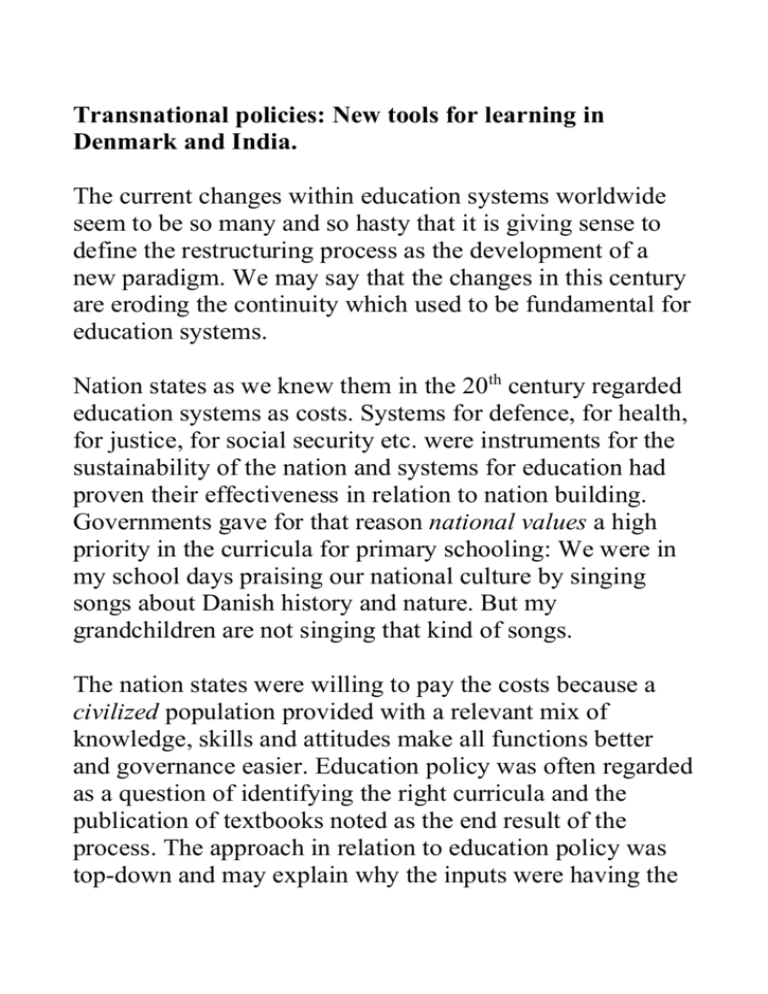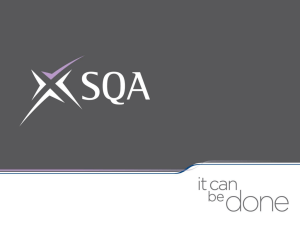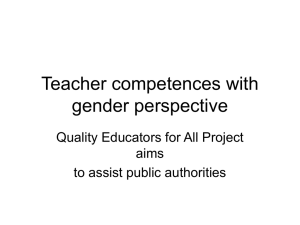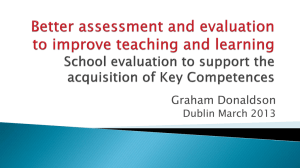Transnational policies: New tools for learning in Denmark
advertisement

Transnational policies: New tools for learning in Denmark and India. The current changes within education systems worldwide seem to be so many and so hasty that it is giving sense to define the restructuring process as the development of a new paradigm. We may say that the changes in this century are eroding the continuity which used to be fundamental for education systems. Nation states as we knew them in the 20th century regarded education systems as costs. Systems for defence, for health, for justice, for social security etc. were instruments for the sustainability of the nation and systems for education had proven their effectiveness in relation to nation building. Governments gave for that reason national values a high priority in the curricula for primary schooling: We were in my school days praising our national culture by singing songs about Danish history and nature. But my grandchildren are not singing that kind of songs. The nation states were willing to pay the costs because a civilized population provided with a relevant mix of knowledge, skills and attitudes make all functions better and governance easier. Education policy was often regarded as a question of identifying the right curricula and the publication of textbooks noted as the end result of the process. The approach in relation to education policy was top-down and may explain why the inputs were having the highest priority. Actually, our understanding of education as a policy concept is linked to that approach. Policy makers in Denmark and India tend to forget that our systems for education in their origin were based on values imported from other countries. We may trace values embedded in our curricula back to policy makers in other countries. The humanistic intention of 1835 formulated by Lord Maccaulay in the British Parliament was that the development of Indian education should be based on European values and the later action plans developed by the rulers were instruments for providing selected Indian children with certain values which were important for the East India Company. The British spoiled Indian values when they imposed their system according to Gandhi. Few Danes of today are familiar with the fact that Martin Luther was involved in the design of a schooling system for selected children. He was the author of Little Catechism the most important Danish textbook in the 16th century and also supervising King Christian III who was Lutheran. Actually, Dr. Johann Bugenhagen, a representative of Martin Luther was after a civil war placed in the Danish Kingdom for two years where his task was to develop regulations for churches and schools. The royal ordinance written in Latin was sent to Luther and accepted by him before it was translated into Danish and printed. The printing technology was a powerful instrument for the development of schooling systems and also used in Northern Germany where Dr. Bugenhagen drafted regulations for eight duchies and cities. Education systems expanded The systems grew in size and developed new layers in Europe and India. The systems for secondary education expanded from the beginning of the 20th century and systems for the education of adults inspired by UNESCO were a reality in the end of the century. The story about higher education is following the same pattern as in the 16th century: The changes were coming from abroad. Dr. Bugenhagen had reorganized Copenhagen University as well and the development of a higher education system in Denmark was based on Lutheran values. Actually, the history of higher education in India has a connection to Denmark. British missionaries at a Danish trading post in Serampore, West Bengal were so entrepreneurial in their handling of the printing press that they accumulated funds. The missionaries wanted to have a university and managed in 1827 to make King Frederik VI sign a charter which gave the university senate the right to grant degrees. The trading post was afterwards bought by the British but Serampore College is still holding the Danish charter for degrees in theology. British universities were by 1857 established in Bombay, Calcutta and Madras but the curricula for higher education were not based on Indian values. The rulers in Denmark and in India wanted to consolidate their power. King Christian III had support from Martin Luther and was able to construct a coalition between state and church and the model was kept in 1849 when the first constitution was written. The royal regulations of 1814 which led to the schooling of all Danish children were part of agricultural reforms and the schooling of selected Indian children became an instrument for the recruitment of staff to the colonial civil service. The approach was top-down in both cases. Stakeholders want a bottom-up approach Education systems were for centuries based on continuity and that is why the current hasty changes are surprising in a historical perspective. Denmark belongs to the European Union (EU) and EU member states are developing themselves into knowledge economies in accordance with the Lisbon Strategy from 2000. One of the consequences is that the national systems for education and training are being restructured through The Open Method of Coordination imposed by the EU. The global economic competition between nation states imply that the national systems are becoming instruments for long term investments in the competences of the workforce. Actually, the Danish Parliament did in 2006 change the formulation of the aims for primary education in order to become more competitive in the future and India is implementing a programme for skills development where the existing work force is the target group. The need for economic growth is the argument. The changes within European higher education may serve as an example. France, Germany, Italy and UK started by 1999 a reform of higher education systems which was named the Bologna Process and based on a voluntary coordination of national policies. Research-based higher education is valued as a tool for innovation and the political process has been successful and is now joined by 47 countries. The Ministers of higher education are meeting each other every second year and decide a number of policy changes which afterwards are implemented by the member states. The communication after the Bologna meeting in Berlin 2003 declared: …Ministers encourage the member states to elaborate a framework of comparable and compatible qualifications for higher education systems, which should seek to describe qualifications in terms of work load, level, learning outcomes, competences and profile. Transnational policy tools were announced and afterwards implemented national governments. It is worth noting that the communication of 2003 did not mention curricula. The EU is supporting and funding the Bologna Process and the Council of EU ministers and the European Parliament passed in 2008 a recommendation of a European Qualification Framework (EQF) with eight levels where the upper three levels are coordinated with the Bologna Process covering the PhD level, the master level, and the bachelor level. Mr. Kapil Sibal, the Indian Minister for Human Resource announced on February 7th, 2012 that India will develop a national vocational qualification framework with seven levels. Denmark has implemented a National Qualification Framework (NQF) which is in conformity with the EQF. The 27 EU member states are following the EQF guidelines and are restructuring their national systems. Other NQF models have been implemented by Australia, New Zealand and countries in Africa and Asia. Transnational policy tools for restructuring education and training are known all over the world because human capital is needed by national economies wanting to become more competitive. Governments move gradually away from the top-down approach and are inviting stakeholders to influence national policy making. What kind of learning outcomes is wanted by employers and others responsible for the development of the current and the future work force? Learning outcomes are replacing curricula Curricula and textbooks have for centuries been instruments for national governance of systems for education and training but are getting less influence on the current long term planning. The existing curricula are rooted in national values but the current implementation of transnational policies are backed up by banks as Asian Development Bank, European Investment Bank and World Bank who ask for restructuring of education systems when they negotiate with weak national economies. It had effect when the EU formulated guidelines for a European Credit Transfer and Accumulation System (ECTS). This policy tool is included in the Bologna Process and was in 2005 recommended by the Ministers when they met in Leuven. Each module earned during a course must according to the ECTS regulations be based on a measurement of the workload of learners. The success story of ECTS can be interpreted as a step towards a bottom-up approach because it is based on an end user perspective. NQFs are among the most effective transnational policy tools because they impose the paradigm of learning. The following simple model may demonstrate how EU member states and countries all over the world are pushing education and national curricula back in favour of learning processes and learning outcomes: INPUT PROCESS PRODUCT OLD curricula teaching process exams NEW problems learning process learning outcomes The old model is based on the governance of rulers like King Christian III and Lord Macaulay: 1) National curricula is the point of departure for understanding the model, 2) the next step is a process based on efforts done by teachers running a module and 3) the final step is exams based on assessments done by teachers. The curricula are instruments for a top-down approach, the model is teachercentered, and linked to a certain well-described academic discipline. The new model is based on transnational policy tools: The logic of the model is 1) Learning outcomes is the point of departure with descriptors telling what learners are expected to know (the old concept knowledge), to understand (the old concept skills) and to do (the new concept competence), 2) the next step is the work of learners, and 3) the final step the identification of a problem which motivates learners. The inclusion of learning outcomes, learning processes and problems motivating learners are placing the new model in the bottom-up approach. The solving of problems is usually not linked to a certain well-described academic discipline because learners work in an inter-disciplinary way. We may say that the old model is linked to the supply of specific national curricula while the new model is linked to the demand of specific learning outcomes. The perspective is as in the ECTS case based on the needs of the end users. The promotion of key competences The concept competence describing what learners can do is among the transnational policy tools within the EQF and was in 2003 mentioned in the communication after the Bologna meeting in Berlin. The Council of EU Ministers as well as the European Parliament recommended in 2006 that EU member states include eight key competences in their development of national strategies: 1) Communication in the mother tongue 2) Communication in the foreign languages 3) Mathematical competence and basic competence in science and technology 4) Digital competence 5) Learning to learn 6) Interpersonal, intercultural and social competences and civic competences 7) Entrepreneurship 8) Cultural expression A relevant question is: Did the EU recommend a transnational curriculum in 2006? The EU member states are supposed to include the eight key competences in efforts done by their national systems but the competences as such are not in favour of national values. The top-down approach usually followed by nation states is not recommended by the EU. Some countries are resisting the recommendation from EU. A recent study of the Nordic countries (Denmark, Finland, Iceland, Norway and Sweden) has shown that inclusion of the eight key competences is having a low priority. The general argument is that all eight key competences already are included in the planning due to the current national policies How will transnational policies affect values? It is usually easy to identify values in curricula developed by nation states. However, the question is: Are these values universal or national? It is obvious that India as a secular state is mainly working for universal values and Denmark will probably in the 21st century cut the link between state and church. Transnational policies are products of the economic competition between nation states: Is this competition an argument for including certain values? The traditional way to develop national curricula is to describe knowledge, skills and attitudes but the NQFs in EU member states are based on the paradigm of learning and ask for knowledge, skills and competences. We may interpret the EU description of key competences as a call for certain values but at least some EU member states are not following the call. Maybe the answer is that value-based education will be supported if the values will benefit national efforts in the global competition or if nation states as in the case of India engage themselves in universal values. The top-down approach once promoted by King Christian III and Lord Macaulay were new then but systems for learning existed before systems for education. The bottom-up approach implemented in the 21st century is not new. References Cort, P. (2010), Stating the Obvious; the European Qualifications Framework is not a neutral evidence-based policy tool. In: European Educational Research Journal. Volume 9. Number 3 (pp. 304-316). Green, A. (1997), Education and State Formation in Europe and Asia. In: Citizenship Education and the Modern State. London: Falmer Press. Halasc, G. & A. Michel (2011), Key Competences in Europe: Interpretation, policy formulation and implementation. In: European Journal of Education. Volume 46, Number 3 (pp.289-306). Kumar, K. (1988), Origins of India`s “textbook culture”. In: Comparative Education Review. Volume 37, Number 4 (pp. 452-464). Moutsios, S. (2009), International organizations and transnational education policy. In: Compare. Volume 39. Issue 4 (pp. 469-481). Pepin, L. (2007), The History of EU Cooperation in the Field of Education and Training: how lifelong learning became a strategic objective. In: European Journal of Education. Volume 42. Number 1 (pp.121-132). Zhao, Y. (2011), (Ed.) Handbook of Asian Education. A Cultural Perspective. London: Routledge . Dr. Søren Ehlers National Centre for Competence Development, Aarhus University, 164 Tuborgvej, 2400 Copenhagen NV, Denmark E-mail: ehlers@dpu.dk







